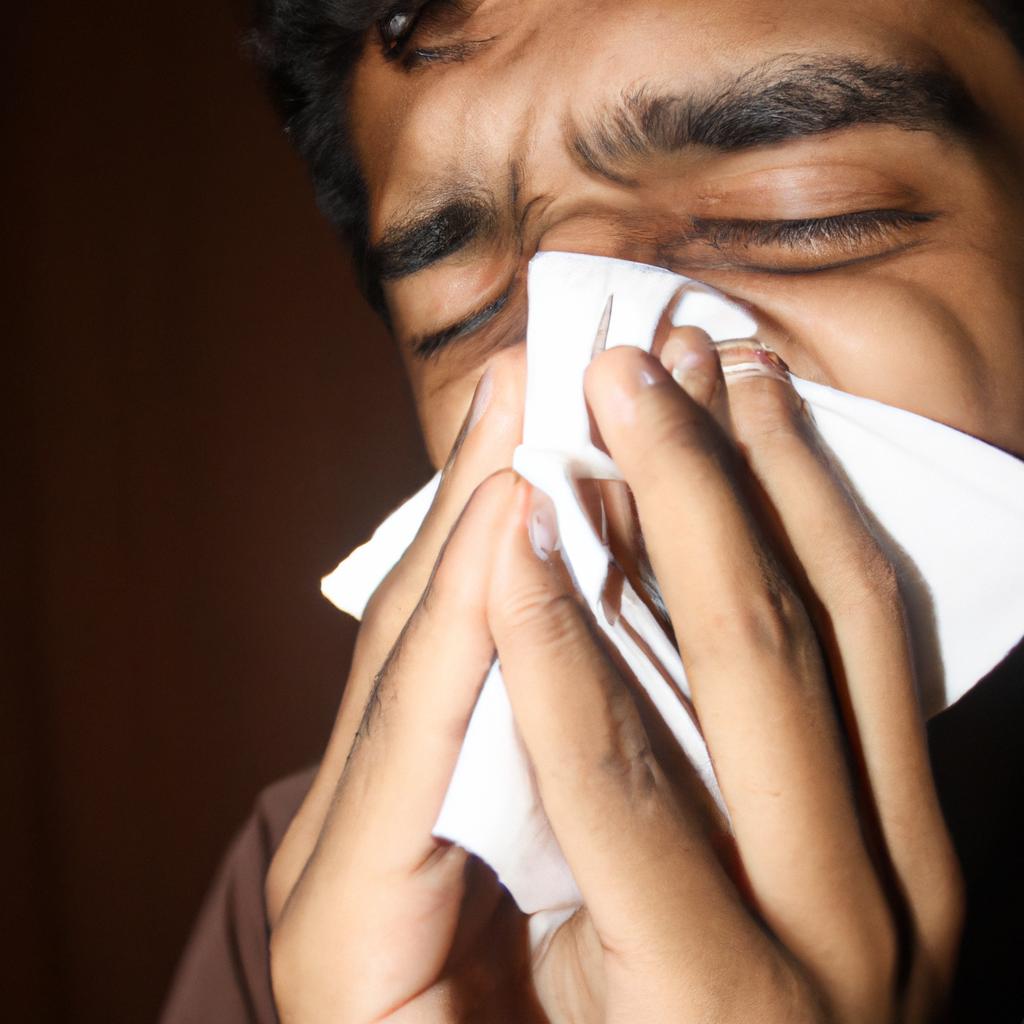Allergies, a common health condition affecting millions of individuals worldwide, can cause significant discomfort and impair daily functioning. Understanding the various aspects of allergy treatment is essential in managing symptoms effectively and improving quality of life for those affected. This article aims to provide vital information on allergy treatment options, including medication, immunotherapy, and lifestyle modifications.
To grasp the significance of comprehensive allergy treatment, let us consider a hypothetical case study involving Susan. Susan, a 35-year-old woman with a long-standing history of seasonal allergies, experiences frequent sneezing, nasal congestion, and itchy eyes during springtime. These symptoms not only disrupt her productivity at work but also hinder her ability to enjoy outdoor activities with her family. Through proper education about available treatments and their potential benefits, Susan gains insight into effective strategies that can alleviate her allergic reactions and enhance her overall well-being.
In this article, we will explore the different types of medications commonly used in allergy treatment. Additionally, we will delve into the concept of immunotherapy as an alternative approach for managing severe allergies. Finally, we will discuss lifestyle modifications that individuals can adopt to minimize exposure to allergens and reduce symptom severity. By familiarizing ourselves with these crucial components of allergy treatment, we can empower ourselves or our loved ones to effectively manage allergies and improve daily functioning.
Medications play a significant role in allergy treatment, providing relief from symptoms and helping individuals maintain control over their allergic reactions. There are several types of medications commonly used for allergies, including antihistamines, decongestants, nasal sprays, and eye drops. Antihistamines work by blocking the effects of histamine, a chemical released during an allergic reaction that causes symptoms such as itching and sneezing. Decongestants help reduce nasal congestion by shrinking blood vessels in the nasal passages. Nasal sprays can provide targeted relief for nasal symptoms like congestion and post-nasal drip, while eye drops can alleviate itchy or watery eyes.
In cases where medication alone does not provide adequate symptom relief or if allergies are severe and significantly impact daily life, immunotherapy may be recommended. Immunotherapy involves exposing the individual to small amounts of allergens over time to desensitize their immune system. This can be done through allergy shots or sublingual tablets or drops placed under the tongue. The goal of immunotherapy is to gradually decrease sensitivity to allergens and reduce the severity of allergic reactions.
Aside from medication and immunotherapy, lifestyle modifications can also contribute to better allergy management. Identifying specific triggers and taking steps to minimize exposure to them is crucial. For example, if pollen is a trigger for allergies, staying indoors during peak pollen times or using air purifiers at home can help reduce symptoms. Regularly cleaning bedding, vacuuming carpets, and avoiding pets or certain foods known to cause allergies are other measures individuals can take to minimize allergen exposure.
In conclusion, comprehensive allergy treatment involves various approaches such as medication, immunotherapy, and lifestyle modifications. By understanding these options and working closely with healthcare professionals, individuals with allergies can find effective strategies that suit their needs. Managing allergies effectively not only alleviates symptoms but also allows individuals to enjoy a better quality of life, free from the discomfort and limitations imposed by allergic reactions.
Understanding Allergies
Imagine a scenario where Sarah, a young girl with a history of asthma, experiences persistent sneezing, watery eyes, and itching all over her body after playing outside in the springtime. These symptoms are not only uncomfortable but also affect Sarah’s daily activities and overall quality of life. This case highlights the impact of allergies on individuals and emphasizes the importance of understanding this common health condition.
Allergies occur when our immune system reacts abnormally to substances that are typically harmless, known as allergens. Common allergens include pollen, pet dander, dust mites, certain foods like peanuts or shellfish, insect stings, and medications. When exposed to an allergen, the body produces antibodies called immunoglobulin E (IgE), which trigger the release of chemicals such as histamine. Histamine is responsible for causing inflammation and various allergic reactions within different organs.
To grasp the complexity of allergies fully, it is essential to recognize their significant effects on both physical well-being and emotional stability. Consider the following bullet points:
- Allergic reactions can range from mild symptoms like runny nose or rash to severe manifestations such as anaphylaxis.
- Living with allergies often requires careful management strategies including avoidance measures and medication use.
- The psychological impact of allergies should not be underestimated as they may lead to anxiety, depression, social isolation, or reduced productivity.
- Allergy-related healthcare costs can be substantial due to medical consultations, diagnostic tests, treatment options, and potential hospitalizations.
In addition to these considerations about allergies’ broader implications on individuals’ lives and society as a whole, it is crucial to understand specific allergic reactions’ signs and symptoms. Such knowledge enables early identification and appropriate intervention before situations worsen. As we delve into the subsequent section about “Common Symptoms of Allergic Reactions,” let us explore how recognizing these indications plays a vital role in managing allergies effectively.
[Transition sentence into the subsequent section about “Common Symptoms of Allergic Reactions.”]Common Symptoms of Allergic Reactions
Allergic reactions can manifest in a variety of ways, affecting individuals differently based on their unique sensitivities. To illustrate this point, let us consider the case of Sarah, a 35-year-old woman who has recently developed an allergy to peanuts. Sarah had always enjoyed snacking on peanut butter sandwiches until one day she experienced hives, difficulty breathing, and swelling after consuming her usual lunchtime treat.
When it comes to allergies, understanding the common symptoms that accompany allergic reactions is crucial. These symptoms can range from mild irritations to severe and potentially life-threatening responses. Some examples include:
- Itchy or watery eyes
- Sneezing and nasal congestion
- Skin rashes or hives
- Anaphylaxis (a severe whole-body reaction)
To further emphasize the impact of allergies on individuals’ lives, we present the following bullet-point list:
- Allergies disrupt daily activities and productivity.
- The fear of experiencing an allergic reaction can lead to anxiety and stress.
- Limited dietary options due to food allergies may result in nutritional deficiencies.
- Severe allergic reactions require immediate medical attention and can be emotionally traumatic for both the affected person and those around them.
| Emotional Impact | Physical Impact | Social Impact |
|---|---|---|
| Anxiety | Fatigue | Isolation |
| Fear | Headaches | Decreased quality of |
| Stress | Difficulty sleeping | life |
| Frustration | Weakened immune system | Relationship strain |
It is evident that allergies extend beyond physical discomfort alone; they have far-reaching effects on various aspects of an individual’s well-being. Acknowledging these impacts allows healthcare professionals and patients alike to approach allergy treatment holistically.
In light of this comprehensive understanding, identifying allergy triggers becomes crucial. By identifying the specific substances or situations that provoke allergic reactions, individuals can take proactive steps to minimize their exposure and manage their allergies effectively. In the subsequent section, we will explore various methods for pinpointing these triggers and discuss strategies for avoiding them.
Please let me know if there is anything else I can assist you with!
Identifying Allergy Triggers
Section Title: Identifying Allergy Triggers
To effectively manage allergies, it is crucial to identify the specific triggers that cause allergic reactions. Understanding these triggers can help individuals avoid or minimize exposure, leading to better control of their symptoms. In this section, we will explore various methods and strategies for identifying allergy triggers.
Case Study Example:
Consider a hypothetical case study involving Sarah, who experiences recurrent sneezing, nasal congestion, and watery eyes whenever she visits her friend’s house. By analyzing potential allergens in her surroundings, Sarah discovers that she has an allergy to pet dander present at her friend’s home. This realization empowers her to take necessary precautions during future visits and seek appropriate treatment options.
Identifying Allergy Triggers – Strategies and Tools:
-
Environmental Assessments:
- Conduct indoor air quality checks for common allergens such as dust mites, mold spores, and pollen.
- Utilize air purifiers with high-efficiency particulate air (HEPA) filters to reduce airborne allergens indoors.
- Regularly clean bedding, carpets, curtains, and upholstered furniture to minimize allergen accumulation.
-
Symptom Tracking:
- Keep a detailed record of allergy symptoms experienced after exposure to different environments or substances.
- Note any patterns or correlations between symptom onset and specific activities or locations.
- Use smartphone apps or paper-based journals to track daily activities and potential triggers systematically.
-
Elimination Diets:
- Under medical supervision, try eliminating suspected food allergens from your diet one by one.
- Monitor changes in symptoms during each elimination phase to pinpoint potential trigger foods.
- Gradually reintroduce eliminated foods while monitoring any subsequent allergic reactions.
-
Patch Testing:
- Patch testing involves applying small amounts of common allergens onto the skin using adhesive patches.
- Observe the skin’s reaction over several days to determine if an allergy is present.
- This method is commonly used to identify contact allergies, such as those caused by certain cosmetics or metals.
In summary, identifying allergy triggers requires a systematic approach that involves environmental assessments, symptom tracking, elimination diets, and patch testing. By utilizing these strategies and tools, individuals can gain valuable insights into their allergic reactions and make informed decisions about allergen avoidance and treatment options.
Understanding how to identify the specific triggers of allergic reactions lays the foundation for effective methods of allergy testing. In the subsequent section, we will explore various diagnostic techniques employed in determining specific allergens responsible for individual sensitivities.
Methods of Allergy Testing
For individuals suffering from allergies, identifying the specific triggers is crucial in managing their symptoms effectively. By pinpointing these triggers, healthcare professionals can provide personalized treatment plans to alleviate allergy-related discomfort. Let’s consider an example of a patient who experiences severe hay fever symptoms every spring due to pollen allergies. Understanding and addressing this trigger will significantly improve their quality of life.
To identify allergens that may be causing allergic reactions, various methods can be employed. These include:
-
Skin Prick Test: This commonly used diagnostic test involves applying small amounts of suspected allergens onto the skin and then pricking or scratching the surface. If a reaction occurs within minutes, such as redness or swelling at the site, it indicates sensitivity to that particular allergen.
-
Blood Tests: Specific IgE blood tests measure the levels of immunoglobulin E (IgE) antibodies in the blood. Elevated IgE levels indicate sensitization to certain allergens.
-
Elimination Diet: Often utilized for food allergies, an elimination diet involves removing potential trigger foods from one’s diet for a specified period before gradually reintroducing them while monitoring for any allergic reactions.
-
Environmental Monitoring: In cases where environmental factors are suspected as triggers, specialized equipment can measure indoor air quality and detect common allergens like dust mites or mold spores.
Understanding what causes allergic reactions empowers individuals with valuable knowledge about their own bodies’ responses and enables them to take proactive steps towards avoiding exposure to triggering substances.
| Trigger | Symptoms | Emotional Impact |
|---|---|---|
| Pollen | Sneezing, itchy eyes | Frustration due to limited outdoor activities |
| Pet dander | Coughing, wheezing | Sadness over inability to keep pets |
| Dust mites | Nasal congestion | Anxiety related to difficulty in breathing |
| Mold spores | Skin rashes, headaches | Irritation caused by persistent symptoms |
Understanding the emotional impact that allergies can have on individuals is essential for healthcare professionals to provide holistic care. By recognizing how allergic reactions affect a person’s daily life and well-being, medical practitioners can tailor treatment plans accordingly.
In the subsequent section, we will explore effective allergy treatment options that aim to alleviate symptoms and enhance overall quality of life. Understanding these methods empowers individuals with knowledge about potential remedies available to them.
Effective Allergy Treatment Options
In order to effectively treat allergies, it is crucial to identify the specific allergens causing the adverse reactions. This can be achieved through various methods of allergy testing. Let’s consider an example: a young child presenting with persistent respiratory symptoms such as coughing and wheezing. In this case, allergy testing could help determine if the child’s symptoms are caused by environmental allergens like pollen or dust mites.
One method of allergy testing is skin prick testing, which involves applying small amounts of potential allergens onto the patient’s forearm or back. The skin is then pricked with a needle, allowing the allergen extracts to enter the epidermis. If an allergic response occurs, characterized by redness and swelling at the site of application, it suggests sensitivity to that particular allergen.
Another approach is blood tests, specifically IgE antibody tests. These tests measure the levels of immunoglobulin E (IgE) antibodies in the blood that are produced in response to exposure to allergens. By analyzing these antibody levels, healthcare professionals can identify any specific allergens triggering an immune reaction in an individual.
Patch testing may also be employed for certain types of allergies, particularly those related to contact dermatitis. Small patches containing common irritants or potential allergens are applied to the patient’s back for a specified period of time. Any resulting skin reactions indicate sensitivities or allergies to those substances.
Understanding which method of allergy testing suits each patient best allows healthcare providers to accurately diagnose their condition and tailor treatment plans accordingly. It empowers individuals suffering from allergies with knowledge about their triggers so that they can take appropriate steps towards alleviating their symptoms and improving their quality of life.
When it comes to treating allergies, there are several options available depending on the severity and type of allergic reaction experienced. Here are some effective approaches:
-
Medications:
- Antihistamines: These drugs block the release of histamine, a chemical responsible for allergy symptoms such as itching and sneezing.
- Corticosteroids: Often administered by inhalation or nasal spray, these medications help reduce inflammation in the airways and relieve congestion.
- Decongestants: Oral decongestants can provide temporary relief from nasal congestion associated with allergies.
-
Immunotherapy:
- Allergy Shots (Subcutaneous Immunotherapy): This treatment involves injecting small amounts of allergens into the body over time to gradually desensitize the immune system and reduce allergic reactions.
- Sublingual Immunotherapy (SLIT): A newer alternative to allergy shots, SLIT involves placing allergen extracts under the tongue to achieve similar desensitization effects.
-
Environmental Control Measures:
- Minimizing exposure to known allergens like pollen, dust mites, or pet dander by using air purifiers, regularly cleaning bedding, and maintaining a clean living space.
- Implementing measures to reduce indoor humidity levels that can promote mold growth and worsen respiratory allergies.
-
Emergency Epinephrine:
- For individuals prone to severe allergic reactions (anaphylaxis), carrying an epinephrine auto-injector is crucial. Prompt administration during an allergic emergency can be life-saving.
Incorporating these treatment options into an individual’s management plan can significantly alleviate allergy symptoms and improve their overall well-being. It is important to consult with healthcare professionals to determine the most suitable approach based on specific needs and circumstances.
Understanding effective methods of allergy testing allows us to accurately diagnose allergies and identify triggers. In the subsequent section about “Preventing Allergic Reactions,” we will explore strategies aimed at minimizing exposure to common allergens for long-term symptom management.
Preventing Allergic Reactions
Building upon the effective allergy treatment options discussed earlier, it is crucial to understand that preventing allergic reactions plays a pivotal role in managing allergies. By implementing preventive measures, individuals can significantly reduce their exposure to allergens and mitigate the chances of experiencing distressing symptoms. In this section, we will explore various strategies and lifestyle changes that can aid in preventing allergic reactions.
Case Study:
Consider Sarah, a 35-year-old woman who suffers from severe pollen allergies. Every spring, she experiences debilitating sneezing fits, nasal congestion, and itchy eyes whenever she goes outside. However, by incorporating certain prevention techniques into her daily routine, Sarah has successfully minimized her exposure to pollen and now enjoys a more comfortable season.
Prevention Strategies:
To assist you in taking proactive steps towards preventing allergic reactions, here are some recommended strategies:
- Keep your living environment clean and free from dust mites.
- Avoid outdoor activities during high pollen count periods.
- Use mattress and pillow covers designed for allergen protection.
- Install air purifiers with HEPA filters to improve indoor air quality.
Taking preventative actions not only helps manage allergies but also provides peace of mind. Consider the following benefits of allergy prevention:
- Enhanced overall well-being
- Improved quality of life
- Reduced reliance on medication
- Minimized disruption caused by allergy symptoms
Table: Common Allergens and Prevention Measures
| Allergen | Prevention Measures |
|---|---|
| Dust Mites | Regularly wash bedding at high temperatures; encase mattresses and pillows |
| Pollen | Stay indoors during peak pollen times; keep windows closed |
| Pet Dander | Limit contact with pets; regularly groom animals |
By implementing these prevention strategies tailored to specific allergens, individuals like Sarah can experience a significant reduction in their allergic reactions. It is important to remember that each person’s allergies are unique, and some preventive measures may be more effective than others depending on individual circumstances.
Incorporating these strategies into your daily routine can go a long way in preventing allergic reactions and alleviating the associated discomfort. By taking proactive steps towards managing allergies, individuals can improve their overall well-being and enjoy a better quality of life.
(Note: The table above should be formatted as markdown format for display purposes.)
 Web Firma
Web Firma



